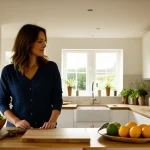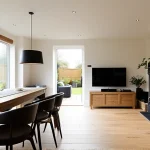Step-by-Step Guide to Transforming Your Small Space
Transforming a small space begins with assessing your space thoroughly and defining what your ideal personal retreat looks like. Identify the key functions you want your sanctuary to serve—whether it’s a peaceful reading nook, a home office, or a cozy resting spot. This clarity helps prioritize both style and functionality.
Next, create a transformation plan focusing on your needs and aesthetic preferences. Prioritising function means selecting versatile furniture and storage that maximises usability without overcrowding. Style should complement your taste and the mood you want your personal retreat to evoke, ensuring the space feels inviting.
Topic to read : How Can You Transform Your UK Home Living Experience This Season?
Essential tools and resources for your small space transformation include measuring tapes, mood boards, and simple design apps to visualise layouts before committing. Additionally, invest in quality paint, textiles, and lighting to elevate comfort and style. With these deliberate steps, your small space transformation becomes manageable and rewarding, turning cramped quarters into a sanctuary tailored just for you.
Space-Saving Design and Layout Solutions
Mastering space-saving design is crucial in any small room layout. The key lies in selecting multi-functional furniture that serves dual purposes—like a sofa bed or a storage ottoman—which maximises usability without occupying excess floor space. When you ask, “How can I make a small space more functional without clutter?” the answer often starts with choosing such adaptable pieces that replace multiple single-use items.
Also read : What role does government policy play in UK tech advancements?
Beyond furniture, explore vertical and hidden storage. Tall shelving, wall-mounted cabinets, and under-bed drawers tap unused space efficiently. For example, using wall hooks or pegboards can keep essentials visible but off surfaces, maintaining cleanliness and order. This approach answers: “What are effective space-saving storage ideas?” by highlighting the importance of elevation and concealment.
Design techniques further maximise perceived space. Light colours, strategic mirror placement, and furniture with sleek profiles create openness and flow. Arranging furniture to allow clear pathways also enlarges room feel. Together, these elements shape a practical yet stylish small space transformation that balances function with aesthetic.
Step-by-Step Guide to Transforming Your Small Space
A successful small space transformation begins by carefully assessing your space to understand its dimensions, lighting, and existing layout. Start by defining your personal retreat goals: ask yourself what activities the space should accommodate and what atmosphere you want to create. Clarifying these goals helps tailor choices, ensuring your retreat feels uniquely yours.
Next, develop a step-by-step guide to transformation that balances function and style. Prioritising usability means selecting furniture and storage that fit your needs without overcrowding. For example, if you need a reading nook, focus on comfortable seating and adequate lighting. If working from home is key, integrate ergonomic elements and organized storage.
Use essential tools and resources to aid your styling process. Measuring tapes guarantee accurate dimensions, while mood boards help visualise colour schemes and textures. Design apps can simulate layouts, saving time and guesswork. Investing in quality finishes like paint and textiles enhances comfort and creates a cohesive look. Following this step-by-step guide empowers you to make informed decisions, transforming cramped corners into inviting, purposeful sanctuaries.
Step-by-Step Guide to Transforming Your Small Space
Begin your small space transformation by thoroughly assessing your space. Measure dimensions precisely and observe natural light sources. Ask yourself, “What do I want my personal retreat to accomplish?” This clarifies your goals—whether to create a peaceful reading nook, an efficient home office, or a tranquil meditation corner. Identifying these priorities shapes your entire transformation plan.
Next, develop a clear step-by-step guide that balances function with style. Prioritising functionality means choosing furniture and storage solutions that meet your daily needs without cramping your space. Style choices—like colour schemes and decorative accents—should evoke the mood you desire, weaving comfort and character into your retreat.
To execute your plan, rely on essential tools. Measuring tapes ensure accurate layouts, mood boards help visualise your chosen palette and textures, and design apps provide a virtual preview to refine your ideas before implementation. Also, invest in quality finishes—paint, textiles, and lighting—that enhance both aesthetics and comfort. This structured approach equips you to transform even the smallest space into a beautifully useful personal retreat.
Step-by-Step Guide to Transforming Your Small Space
Begin your small space transformation by accurately assessing your space. Measure dimensions carefully and observe natural light patterns. Ask yourself, “What activities will my personal retreat support?” This question is crucial. Whether you want a workspace, reading nook, or relaxation area, defining these goals shapes every decision you make.
Next, develop a clear step-by-step guide that balances function and style. Prioritise function by selecting furniture and storage that fit your lifestyle without crowding. Styles should reflect the mood you desire, integrating colour schemes and textures to make the space inviting.
To put your plan into action, use essential tools like measuring tapes, mood boards, and design apps. Measuring tapes ensure dimensions are accurate and furniture fits perfectly. Mood boards help visualise colours and textures, keeping your style cohesive. Design apps simulate layouts, minimizing guesswork.
Finally, invest in quality finishes such as paint, lighting, and textiles to enhance both look and comfort. This structured approach empowers you to convert even the smallest area into a stylish, functional personal retreat.
Step-by-Step Guide to Transforming Your Small Space
Embarking on a successful small space transformation starts with assessing your space thoroughly. Measure every corner and note natural light sources. Crucially, identify your personal retreat goals by asking: “What activities or moods should this space accommodate?” Whether it’s a cozy reading nook or a productive work area, clarifying these intentions steers your entire project.
Next, create a clear step-by-step guide that balances function and style. Prioritise furniture and storage solutions that serve daily needs without overwhelming the room. For example, compact desks enhance workspaces, while soft textiles and lighting boost comfort and aesthetic appeal, aligning with your retreat’s mood.
Essential tools streamline this process. Accurate measuring tapes ensure furniture fits perfectly. Mood boards help you visualise colour schemes and textures, keeping your style coherent. Design apps allow you to play with layouts before purchasing, reducing guesswork. Prioritising these elements in your small space transformation empowers you to craft a retreat that is both beautiful and highly functional.



